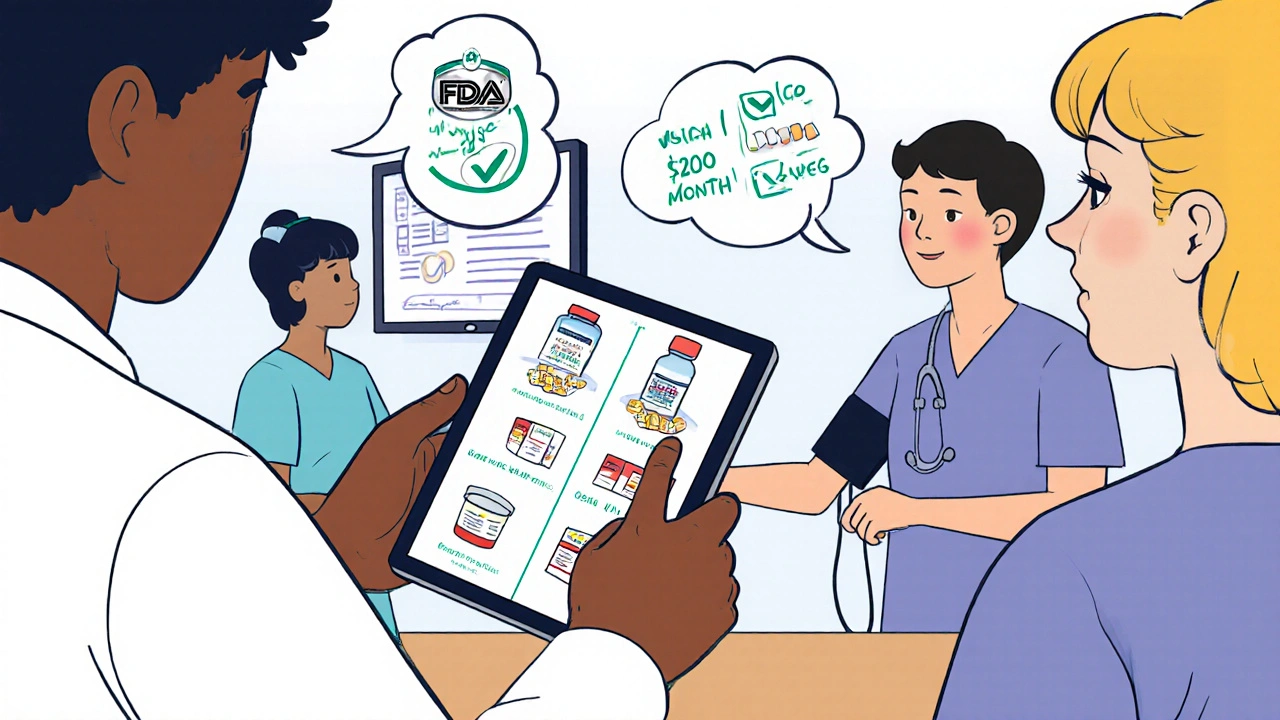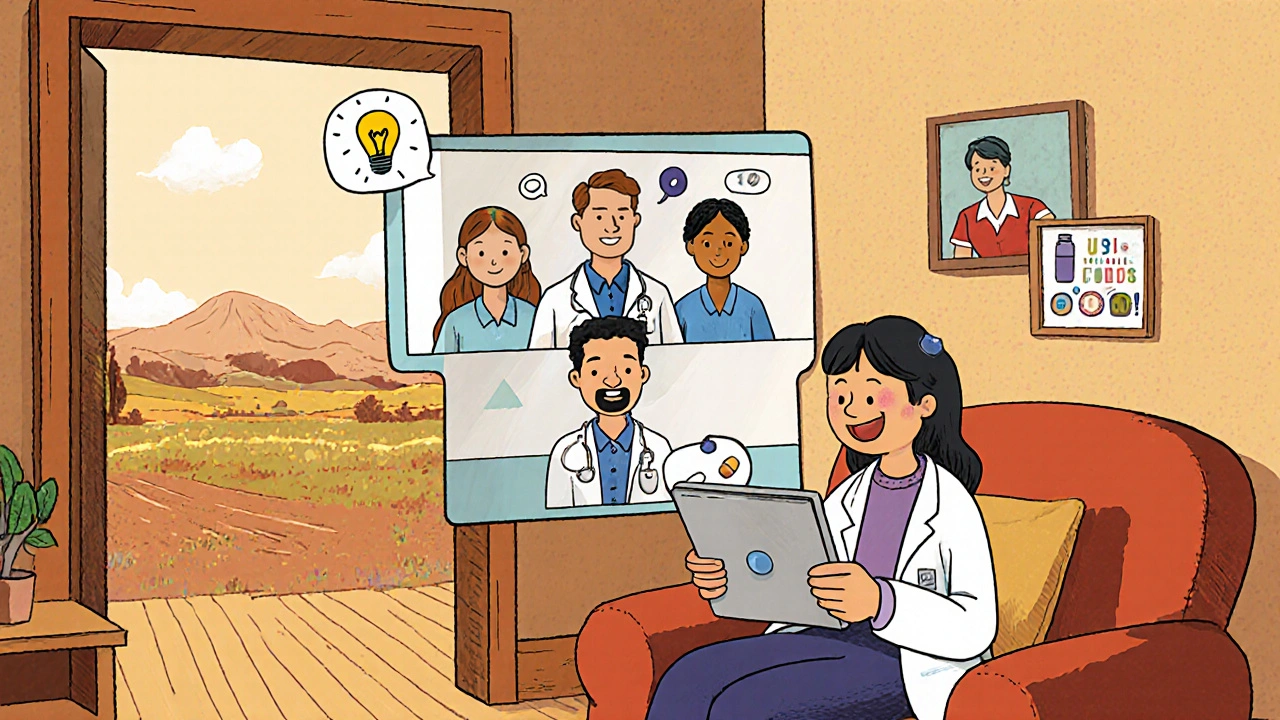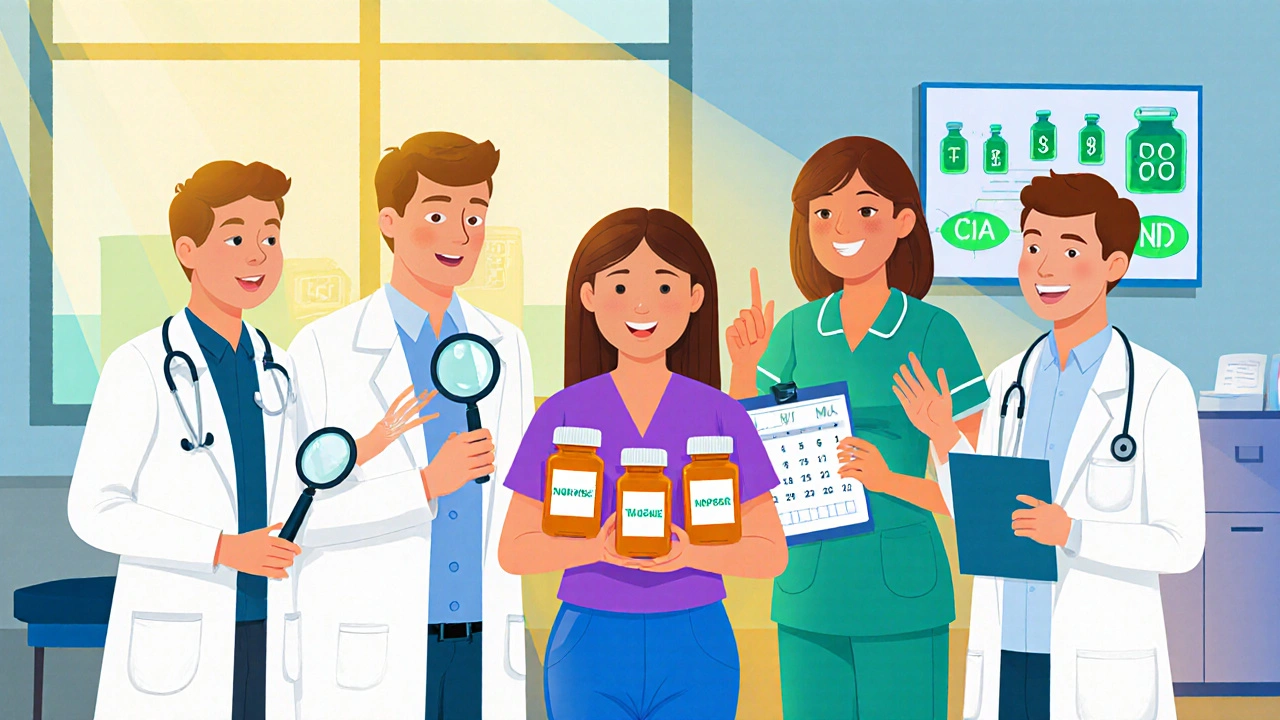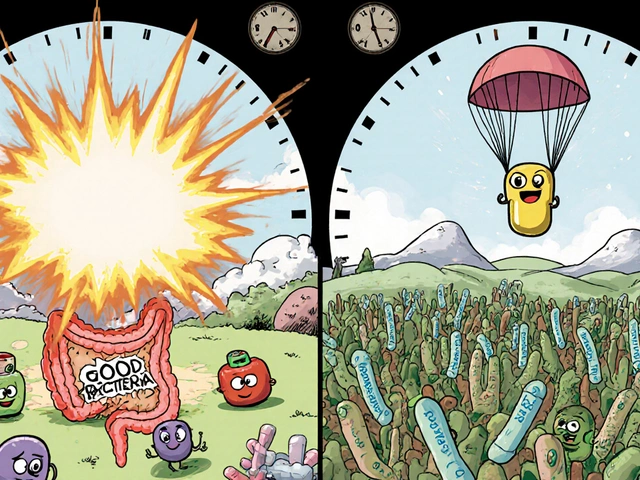When a patient walks into a clinic with five prescriptions, high blood pressure, diabetes, and a $300 monthly drug bill, who’s really in charge of their medication plan? Not just the doctor. Not just the pharmacist. It’s the team-and that’s where real change happens.
Why Team-Based Care Is Changing How Medications Are Prescribed
For decades, prescribing medication was a solo act. The doctor wrote the script, the patient picked it up, and if something went wrong, everyone shrugged. But that model broke down when patients started juggling multiple chronic conditions. A 2013 study from the National Center for Biotechnology Information found that patients with three or more chronic diseases and five or more medications were at high risk for dangerous interactions, missed doses, and unnecessary costs. The answer wasn’t more doctors. It was better teamwork. Team-based care isn’t a buzzword. It’s a structured system where pharmacists, nurses, care coordinators, and physicians work together-each with defined roles-to manage medications. The goal? Better outcomes, fewer hospital visits, and lower costs. And the biggest win? Getting patients on generic drugs when they’re safe and effective.Who Does What in a Medication Management Team
In a well-run team, everyone has a job. No overlap. No gaps.- Physicians handle complex diagnoses, adjust treatments for acute changes, and sign off on final decisions. They’re the captain, but they don’t row every oar.
- Pharmacists are the medication detectives. They review every drug for interactions, duplication, and cost. They flag when a brand-name drug can be switched to a generic without losing effectiveness. One study showed pharmacist involvement reduced medication errors by 67%.
- Nurses and Medical Assistants monitor blood pressure, glucose levels, and kidney function. They catch early signs that a drug isn’t working-or is causing side effects. They also educate patients on how to take pills correctly.
- Care Coordinators make sure the team talks. They update electronic records, schedule follow-ups, and bridge gaps between specialists and primary care.
How Generic Prescribing Works in a Team Setting
Generic drugs aren’t cheaper because they’re worse. They’re cheaper because the patent expired. But many patients-and even some doctors-still think brand names are better. That’s where pharmacists step in. In team-based care, pharmacists don’t just suggest generics. They explain why. They show patients the data: same active ingredient, same FDA approval, same clinical outcomes. They use simple language: “This pill works just like the expensive one, but it’s $150 cheaper a month.” A patient on Healthgrades wrote: “The pharmacist caught three interactions my doctor missed and switched me to generics that saved me $200 monthly.” That’s the power of having a medication expert on the team. The team also uses tools like Collaborative Practice Agreements (CPAs). These are formal contracts between pharmacists and physicians that let pharmacists adjust doses, switch medications, or initiate therapy-under agreed-upon rules. In states with strong CPAs, generic prescribing rates jumped by 30% in just 18 months.
The Real Savings: More Than Just Drug Costs
Switching to generics saves money-but that’s only part of the story. Team-based care cuts costs in three big ways:- Reduced hospitalizations: A 2022 analysis showed team-based models cut readmissions by 17.3%. Why? Better medication management means fewer overdoses, side effects, or missed doses that land people in the ER.
- Less duplicate testing: When everyone on the team knows what drugs a patient is on, they don’t order the same labs over and over. Testing costs dropped by 22.8% in one health center.
- Lower overall spending: PureView Health Center found team-based care saved $1,200-$1,800 per patient annually. Most of that came from switching to generics and avoiding preventable ER visits.
Where It Falls Short-and How to Fix It
Team-based care isn’t magic. It has hurdles. Some physicians resist. They’re used to being in control. One doctor on Doximity said it added 2.5 hours of admin work per week-until workflows were fixed. That’s common. The first three to six months are messy. Communication breakdowns happen too. The Commonwealth Fund found 12% of patients reported confusion when team members didn’t sync up. A pharmacist changes a drug, but the nurse doesn’t know. The patient gets conflicting instructions. The fix? Daily 15-minute huddles. Standardized protocols. Electronic health records that update in real time. And training. Pharmacists need PharmDs and post-graduate residencies. Nurses need clear guidelines. Physicians need to trust their team. The VA Health Services Research report found setup costs run $85,000-$120,000 per practice. But the ROI kicks in within 18 months. And with 92% of healthcare executives planning to expand these teams by 2026, the writing’s on the wall.
The Future: AI, Telepharmacy, and Wider Access
The next leap? Technology. At Mayo Clinic, AI tools now scan patient records and suggest generic alternatives based on clinical history, cost, and insurance coverage. In pilots, this boosted appropriate generic use by 22% and cut adverse events by 9.3%. Telepharmacy is expanding access too. In rural areas where pharmacists are scarce, virtual consultations let patients get medication reviews from home. Between 2020 and 2023, telepharmacy use grew by 214%. CMS now requires all Medicare Advantage plans to offer comprehensive medication management. And the 21st Century Cures Act gives pharmacists broader legal authority to act in teams. This isn’t the future. It’s happening now.What Patients Should Expect
If your care team offers team-based medication management, here’s what to look for:- A pharmacist who asks about every pill you take-even over-the-counter ones.
- Clear explanations about why a generic was chosen.
- Follow-up calls or messages to check how you’re doing.
- One person coordinating between your specialists.
What Providers Need to Start
For clinics thinking about this:- Define roles: Who does what? Write it down.
- Build CPAs: Use CDC templates. Don’t wing it.
- Train your team: Pharmacists need 16-24 hours of training. Nurses need protocols. Doctors need mindset shifts.
- Upgrade your EHR: Make sure everyone can see updates instantly.
- Start small: Pilot with 10-20 high-risk patients first.
Can pharmacists really prescribe generics without a doctor’s approval?
In many states, yes-under Collaborative Practice Agreements (CPAs). These are formal contracts between pharmacists and physicians that allow pharmacists to switch medications, adjust doses, or initiate therapy for specific conditions like hypertension or diabetes. The physician retains oversight, but day-to-day decisions on generics can be delegated. This is legally supported by the 21st Century Cures Act and CMS guidelines.
Are generic drugs as safe and effective as brand-name ones?
Yes. The FDA requires generics to have the same active ingredient, strength, dosage form, and route of administration as the brand-name drug. They must also meet the same strict manufacturing standards. Studies show no difference in clinical outcomes for conditions like high blood pressure, cholesterol, or diabetes. The only differences are in inactive ingredients-which rarely affect patients.
Why don’t all clinics use team-based care for prescribing?
Cost and culture. Setting up a team requires upfront investment-$85,000 to $120,000 per practice for staffing, training, and tech. Many small clinics can’t afford it. There’s also resistance from providers used to working alone. Reimbursement is still limited-only 41% of team-based medication services are fully covered by insurers. But Medicare and private payers are moving fast to change that.
Who qualifies for team-based medication management under Medicare?
As of 2023, Medicare Part D beneficiaries who take four or more chronic disease medications, have three or more chronic conditions, and spend over $4,000 annually on drugs qualify. This expansion added 4.2 million more people to the program. Most plans require a referral from a doctor, pharmacist, or pharmacy benefit manager.
How do I know if my care team is truly team-based?
Ask these questions: Is there a pharmacist on staff who reviews all your meds? Do they talk to your doctor regularly? Do you get a follow-up call after a medication change? Is there one person who coordinates between specialists? If the answer is no to any of these, your team may be fragmented-not integrated. True team-based care means shared goals, shared records, and shared responsibility.


